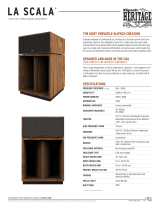Page is loading ...

The Evolution of TOA’s
Horn Speaker Driver Unit
- On the Road to the TU-660 -
We supply sound, not equipment.
www.toa.jp

TOA has been manufacturing horn speakers practically from the
company’s very beginning, over eighty years ago in 1934, and today
we are recognized even among our longstanding industry
contemporaries as a veteran of highest expertise in this field. By
1949 we had succeeded in developing Japan’s rst reex-type horn
speaker. We have always dedicated ourselves to being “an
international company contributing to human society through sound
and communication,” valuing above all the physical craftsmanship
that allows the delivery of the clearest possible sound information to
listeners. In 1962, an inquiry from abroad led us to conduct
transmission testing on an ultra-large PA system. This system, which
used a 6.6-meter horn and a 4kW transistor amplifier, marked a
transmission distance of 12 kilometers. This achievement would
prove instrumental in laying out our destiny of long-running
involvement in outdoor public address systems.
TOA-developed horn speakers were often painted blue, and they
would become widely familiar as “blue trumpets” unique to TOA. In
Indonesia, where we established both factory and sales facilities in
1976, TOA horn speakers became such a part of the public
landscape that they were often referred to as “Toas.” They are still a
conspicuous part of everyday life there, most notably for public
address among the country’s many mosques.
Out in the eld, there is also an inherent need to have horn speakers
deliver higher volume and send the sound farther. Often, however,
attempts to meet this need through excessive power input cause
malfunction by damaging or even destroying the speaker’s driver
unit. Therefore, in addition to
improving frequency characteristics,
improving driver unit durability is
also an issue requiring better
solutions.
Additionally, the events of recent
years have brought us to
understand that in the disaster
prevention market, improving
frequency characteristics not only
improves articulation, it also has a
positive impact on long-distance
sound transmission capability.
Horn speakers are comprised of a driver unit and a horn, and thus
achieve highest efficiency through impedance matching with the air.
The sound pressure drops on both sides of the 1–2kHz range,
however, resulting in certain distinctive audio characteristics that
cannot be considered favorable in terms of creating good-quality
sound.
Improving these high and low range frequency characteristics is one
of the issues key to improving horn speaker sound quality.
Particularly, we now understand that improving the high range
contributes greatly to improving the articulation of outdoor
broadcasts. Attenuation in the air is more conspicuous for the high
frequency ranges.
Improvement of Articulation Improvement of Durability
TOA & Horn Speakers
Issues for Horn Speakers
- 01 -
Even today, horn speakers represent one of the fundamental shapes
of public address speakers, offering a simple PA system that remains
more indispensable than ever in delivering public announcements.
In Japan, too, where natural disasters are frequent, horn speakers are
an essential component in the outdoor emergency notication systems
used for broadcasting evacuation instructions and other vital
information. Naturally, the demand for the clearest possible outdoor
broadcasting sound is strong in this market.
In 2011, the Great Tohoku Earthquake caused a massive tsunami that
devastated a great number of Japanese coastal towns and villages,
taking the lives of many who were unable to escape in time. As this
disaster unfolded, the sheer number
of outdoor speakers calling out
evacuation instructions caused
pronounced sound overlaps that made
their announcements difficult to hear.
And in many cases, the speakers were
simply swept away by the rushing
waters. Reflecting on these systemic
aws, TOA has been developing long-
range speakers capable of delivering
clear announcements with fewer
speakers over longer distances, and
we have been testing these repeatedly
in metropolitan environments to
continue deepening our expertise in
outdoor sound broadcasting and
reinforcement.

TOA horn speaker driver units can be divided into several generations based on their diaphragm materials and constructions. In the past, we used
dome-type diaphragms made of phenol-impregnated Conex. In 2004, we switched the material to polyimide, and in our most recent TU-660 we have
also changed the diaphragm construction from dome-type to ring-type. Each of these various changes have aimed to improve sound quality
(frequency characteristics), product quality, durability, and productivity. The details of this development process are explained below.
The diagram above shows a graphical representation of the state of reverse vibrations at two different
frequencies. The lower frequency is on the left, the higher frequency on the right. Vibration is shown in blue,
reverse vibration in red. This shows that areas of reverse vibration increase suddenly at the border of certain
frequencies.
Diaphragm
construction
TU-15/25/35/50 (1978)
~TU-730/750 (Japan 2000–present*)
TU-630/650 (overseas 1998–2008)
* TU-750 only
Conex (fabric), phenol (resin) Polyimide (multiple types studied) Polyimide
Dome
A
B
C
D
Dome Ring Ring
TU-730A/730AM (Japan 2004–present)
TU-631/651 (overseas 2008–present)
Start of R&D on driver unit using
ring-type diaphragms (2012)
TU-760 (Japan 2017–)
TU-660 (overseas 2017–)
Diaphragm
materials
High Frequency
Characteristics
Low Frequency
Characteristics
Quality &
Durability
Productivity
Phenol’s susceptibility to
humidity leads to deformation and
greater chance of voice coil friction
Material improves
low range performance
Aim: To improve
high range performance
by reducing divided vibration
with a harder structure
Adaptations to the phasing plug design
further improves high range performance
Improved upper cover heat dissipation,
further improving durability
Issue: Harder structure
degrades low range performance.
Aim: To prevent voice coil friction
by reducing divided vibration
with a harder structure
Stable quality
Requires 1 month curing time
Adaptations to the bottom plate
design improves low
range performance
Patent
Pending
Patent
Pending
No curing timeNo curing time No curing time
Change materials
Part 01.
Replacing Phenol-Impregnated Conex with Polyimide
A
B
C
D
Divided vibration and high
frequency drop characteristics
The poor high range characteristics of horn speaker driver units result from
the fact that the dome-type construction makes it more likely for divided
vibrations to occur. “Divided vibrations” refers to the various vibrations
occurring within the diaphragm when it does not vibrate in a uniform manner.
When certain surfaces within the dome surface are vibrating in opposition to
other surfaces on the diaphragm, the speaker will have difficulty sending out
a clear sound. This phenomenon occurs most conspicuously from a certain
frequency up through the high ranges. The relative softness of polyimide
materials renders them more vulnerable to such divided vibrations. Improving
the high frequencies against this problem is a subject for efforts going
forward.
Improved product quality
Phenol’s susceptibility to humidity makes it vulnerable to post-fabrication
deformation of the dome shape, a flaw which can lead to friction between
voice coil and magnet and eventual diaphragm damage. For this reason, we
switched to polyimide that is more resistant to moisture than phenol.
Improved productivity
While phenol-impregnated Conex requires about a month of curing time
before the diaphragm becomes usable, this process is unnecessary with
polyimide, and the finished product is ready for actual use just two minutes
after formation. The adoption of polyimide therefore greatly improved
productivity.
Improved low frequency characteristics
Polyimide is made of softer materials than phenol-impregnated Conex.
Generally, the more pliable the diaphragm material, the more suited it is to
generating sounds in the lower frequency ranges. Therefore, our adoption of
polyimide has allowed the production of sound offering a “thicker,” more
“solid” impression than previously available in horn speakers.
- 02 -
The Process Leading to the TU-660

Ring-type diaphragms are used in tweeters employed in large-scale sound reinforcement
systems and in the pure audio eld. TOA has been attempting to use these in full-range (wide
reproduction frequency band) applications.
The diagram shows the differences in vibration between dome and ring diaphragms, low frequency vibration on the left, high frequency vibration
on the right. Here we see reverse vibrations (red) occurring in the dome diaphragm at the higher frequency, whereas the ring diaphragm is
relatively free of these and provides almost uniform vibration.
Dome-type diaphragms Ring-type diaphragms
Dome-type Ring-type
Asymmetry Symmetry
Ring
Change diaphrogms
Part 02.
Studying the use of Ring-Type Diaphrogms in Horn Speaker Driver Units
C
D
B
A
Improved high frequency characteristics
Since ring-type diaphragms have a more symmetrical construction than
dome-type ones, divided vibrations are less likely to occur, and therefore they
are a good candidate for extending reproducible frequency toward the high
ranges.
The diagram shows the differences in vibration between dome and ring
diaphragms, low frequency vibration on the left, high frequency vibration on
the right. Here we see reverse vibrations (red) occurring in the dome
diaphragm at the higher frequency, whereas the ring diaphragm is relatively
free of these and provides almost uniform vibration.
Improved durability
The occurrence of reverse vibration when under excessive input load is one
cause of axial deviation, and we think reducing this will help improve
durability.
Effects on low ranges
While the adoption of ring diaphragms does improve the high ranges, they
are not inherently well suited to reproducibility in the low ranges. The dilemma
is that while the adoption of polyimide improves the low ranges, the ring
construction itself results in poorer low range output.
- 03 -
The Process Leading to the TU-660

Further Improving Durability
Coil burnout under excessive input loads is caused by the heat
generated by the driver unit. When the heat resulting from excessive
input is sustained, it can build up to the point that it melts the resin
insulating the coil wires from one another, causing them to short
circuit. This means that finding ways to make heat dissipate away
from the coil is one important factor underlying speaker durability.
In the TU-660 we added a heat-dissipating fan at the upper cover
and increased the surface area, and these two measures combined
have doubled heat dissipation.
Take advantage of the improved quality, durability, and productivity obtained by using
polyimide, and maintain the high range performance benefits of ring-type diaphragms,
but also find a new way to improve low range frequency performance.
Improving low range characteristics
Driver units now have a hole in their bottom plate, which allows air to
flow through. This leads to flexibility in the vibration systems
containing air, leading in turn to improved low range reproduction
performance. A long trial-and-error process resulted in an
understanding of the optimum design for this, and we have applied
for a patent on this completely new method of dealing with the low
range problems associated with ring-type diaphragms.
Further improving high range characteristics
We’ve also incorporated an innovative new idea into the design of
the phasing plug. Usually this area is a bottleneck for the sound
path, so gradually widening it achieves high efficiency. On the flip
side, the process of widening the sound path also loses high range
performance. In other words, there is a trade-off between high
efficiency and high range performance.
The TU-660 follows this construction, but makes a bold adjustment
to the usual approach, changing the orientation of the air
passageway toward the exit and making it narrow gradually, a
design that overcomes the deterioration of high range performance
usually occurring during the process.
Finding a solution
Part 03.
Birth of TU-660
D
B
C
A
TU-660
Conventional
従来構造
新構造
Conventional TU-660
- 04 -
The Process Leading to the TU-660
Patent
Pending
Patent
Pending

Input + Power
TU-651 (dome x polyimide)
Low frequency characteristics improve significantly when phenol is replaced by
polyimide. To compare with phenol characteristics, see Area C in the Fig. #2.
TU-660 (ring x polyimide)
The ring-type diaphragm is less well suited to low frequency reproduction, but the addition
of a vent hole improves the low range. This also improves sound pressure level by 3 dB
(equivalent to a two-fold increase in amplifier power) over the TU-651.
Company A (dome x phenol)
It is clear how poor phenol is when it comes to low range reproduction. TOA avoids this
problem by using polyimide instead. See Area A in Fig. #1 for a graph of TU-651
characteristics.
TU-660 (ring x polyimide)
While the ring-type diaphragm is disadvantageous for low range reproduction, the
addition of a vent hole improves the low range. There is no comparison to phenol.
Company A (dome x phenol)
Major drop observed above 5kHz.
TU-660 (ring x polyimide)
The TU-660’s most major improvement are its reproduction of sound up through 8kHz. It
may be possible to raise the dip occurring just before 8kHz using PEQ. In a driver unit
incapable of reproducing sounds in this range, such a dip cannot be raised even using
PEQ.
TU-651 (dome x polyimide)
In actual practice, this configuration shows a major dip in the high range. This is
attributable to divided resonances caused by the driver, and it does not improve even
when parametric EQ (PEQ) is used.
TU-660 (ring x polyimide)
Sound is reproduced strongly up through 8kHz, which is the TU-660’s most major
improvement. The dip occurring just before 8kHz can be raised using the PEQ.
Because the TU-660 allows high range reproduction, it is possible to use EQ to raise SPL
around 5–8kHz. Further, by suppressing SPL around 1–2kHz, flat characteristics can be
achieved even in a horn speaker.
This solid reproducibility in this range doesn’t merely improve sound quality, it also
improves the sense of sound pressure and long-distance transmission capability,
ultimately linking to improved articulation.
The graphs above compare the linearity of frequency characteristics against input power
levels for the ring-type TU-660 construction (above) and dome-type construction of other
driver units (below).
When output increases, the volume does not necessarily increase while maintaining the
same frequency characteristics, and at some points there are significant changes in these
characteristics. The graphs above show the differences in frequency characteristics
between those for each applied input power and those recorded when 1W input is
applied. With the ring diaphragm, there is hardly any change in these characteristics even
as input power increases (indicating high linearity), whereas with the dome diaphragm,
even as input power increases, output does not increase correspondingly on the high
range side, suggesting a deterioration of articulation in the case of loud sound.
Comparison of frequency characteristics
against conventional models
Fig. #1
Correction by PEQ
Fig. #3
Comparison of linearity with conventional products
Fig. #4
Comparison of frequency characteristics against
other company’s models
Fig. #2
Area A Area C
Area D
TOA/TU-660
TOA/TU-651
A
B
TOA/TU-660
Company B
Company A
C
D
Area B
- 05 -
TU-660 Advantages as seen in Measurement Data
Correction by PEQ
Before EQ Correction

- 06 -
TU-660/660M Characteristics Diagrams
TU-660/M with TH-650 TU-660/M with TH-660

TU-660
Applicable Horns TH-650, TH-660
Rated Input 60 W
Rated Impedance 16 Ω
Sensitivity
110 dB (1 W, 1 m) (When operated with
JIS C 5504 standard horn.)
Frequency Response
150 Hz -8 kHz (When operated with JIS C 5504
standard horn.)
Dust/Water Protection IP65 (When a driver is operated with a horn.)
Horn Coupling 1 -3/8 18 threads (inch screw)
Polarity Hot: Black, Com: White
Operating Temperature
-20 °C to +55 °C (-4 °F to +131 °F) (no condensation )
Finish
Flange: Aluminum, gray, powder coating
Rear cover: ABS resin, gray
Screws: Stainless steel
Speaker cable: Polyvinyl chloride insulated cabtyre
cable
(6 mm (0.24”) in diameter, 600 mm (23.62”) in length)
Dimensions ø139 x 108 (D) mm (ø5.47” X 4.25”)
Weight 2 kg (4.41 lb)
Option
Driver unit cover: UC-200A
Matching transformer: TM-30T, TM-60T
Specifications are subject to change without notice.
(1712) 833-61-100-38-01
TOA Corporation
www.toa.jp
DRIVER UNIT 60W
TU-660
TU-660M
Applicable Horns TH-650, TH-660
Rated Input 60 W
Line Voltage 100 V line or 70 V line
Rated Impedance
100 V line: 170 Ω (60 W), 330 Ω (30 W),
670 Ω (15 W)
70 V line: 83 Ω (60 W), 170 Ω (30 W),
330 Ω (15 W), 670 Ω (7.5 W)
Sensitivity
110 dB (1 W, 1 m) (When operated with JIS C
5504 standard horn.)
Frequency Response
150 Hz -8 kHz (When operated with JIS C 5504
standard horn.)
Dust/Water Protection IP65 (When a driver is operated with a horn.)
Horn Coupling 1 -3/8 18 threads (inch screw)
Polarity Hot: Black, Com: White
Operating Temperature
-20
°
to +55
°C
(-4
°
F to +131
°
F) (no condensation)
Finish
Flange: Aluminum, gray, powder coating
Rear cover: ABS resin, gray
Screws: Stainless steel
Speaker cable: Polyvinyl chloride insulated cabtyre
cable
(6 mm (0.24“ lin diameter, 600 mm (23.62“ lin length)
Dimensions ø139 x 151 (D) mm (ø5.47” x 5.94”)
Weight 2.7 kg (5.95 lb)
Option Driver unit cover: UC-200A
DRIVER UNIT 60W WITH TRANSFORMER
TU-660M
TU-660/660M Specifications
/


